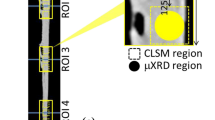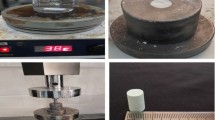Abstract
Bone’s adaptation occurs in response to mechanical loads. In vivo experimental studies explained that cortical bone envelopes (periosteal and endocortical) and their anatomical regions (anterior, posterior, lateral, medial) experience differential loading-induced osteogenesis. It has always been a challenge to establish a computer model to precisely predict such non-uniform new bone formation at the cortex due to mechanobiological stimuli such as strain or canalicular fluid flow. Lacunar permeability governs canalicular fluid velocity magnitude in bone-cross section. Anatomical variations of permeability could be the reason of differential fluid flow response which causes distinct site-specific bone formation. Therefore, it is important to compute poromechanical properties which are required to compute flow distribution. Lacunar canalicular permeability of the periosteal and endosteal surfaces in different anatomical locations has not been well reported. Thus, this paper estimates the poromechanical properties of cortical bone specially the permeability at periosteal and endocortical envelopes in their different anatomical regions, i.e. medial, lateral, anterior and posterior. Nanoindentation technique in combination with poroelastic optimization technique was employed. The result indicates that the endocortical surface was found to be more permeable than periosteal surface. Moreover, medial and lateral sides were also found more permeable than the other two regions, namely anterior and posterior. A clear understanding on cortical bone permeability will help researchers to precisely simulate the site-specific osteogenesis.
Access this chapter
Tax calculation will be finalised at checkout
Purchases are for personal use only
Similar content being viewed by others
References
Kumar R, Tiwari AK, Tripathi D, Mishra A (2022) Electromagnetic field induced alterations in fluid flow through lacuno-canalicular system of bone. Int J Mech Sci 217:107036
Willie BM, Zimmermann EA, Vitienes I, Main RP, Komarova SV (2020) Bone adaptation: safety factors and load predictability in sha** skeletal form. Bone 131:115114
Lanyon LE, Rubin C (1984) Static vs dynamic loads as an influence on bone remodelling. J Biomech 17:897–905
Tiwari AK, Prasad J (2016) Computer modelling of bone’s adaptation: the role of normal strain, shear strain and fluid flow. Biomech Model Mechanobiol 1–16. https://doi.org/10.1007/s10237-016-0824-z
Srinivasan S, Weimer DA, Agans SC, Bain SD, Gross TS (2002) Low-Magnitude mechanical loading becomes osteogenic when rest is inserted between each load cycle. J Bone Miner Res 17:1613–1620
Srinivasan S, Ausk BJ, Poliachik SL, Warner SE, Richardson TS, Gross TS (2007) Rest-inserted loading rapidly amplifies the response of bone to small increases in strain and load cycles. J Appl Physiol 102:1945–1952. https://doi.org/10.1152/japplphysiol.00507.2006
Cullen D, Smith R, Akhter M (2001) Bone-loading response varies with strain magnitude and cycle number. J Appl Physiol 91:1971–1976
Tiwari AK, Kumar R, Tripathi D, Badhyal S (2018) In silico modeling of bone adaptation to rest-inserted loading: strain energy density versus fluid flow as stimulus. J Theor Biol 446:110–127
Kumar R, Tiwari AK, Tripathi D, Shrivas NV, Nizam F (2019) Canalicular fluid flow induced by loading waveforms: a comparative analysis. J Theor Biol 471:59–73
Srinivasan S, Gross T (1999) Canalicular fluid flow in bone: a basis for bone formation at sites of minimal strain. 45th Ann Meet Orthop Res Soc Poster
Gardinier JD, Townend CW, Jen K-P, Wu Q, Duncan RL, Wang L (2010) In situ permeability measurement of the mammalian lacunar–canalicular system. Bone 46:1075–1081
Wang B, Zhou X, Price C, Li W, Pan J, Wang L (2013) Quantifying load-induced solute transport and solute-matrix interaction within the osteocyte lacunar-canalicular system. J Bone Miner Res 28:1075–1086
Wang L (2018) Solute transport in the bone lacunar-canalicular system (LCS). Curr Osteoporos Rep 16:32–41
Kumar R, Tiwari AK, Tripathi D, Sharma NN (2020) Signalling molecule transport analysis in lacunar–canalicular system. Biomech Model Mechanobiol 19:1879–1896
Price C, Zhou X, Li W, Wang L (2011) Real-time measurement of solute transport within the lacunar-canalicular system of mechanically loaded bone: direct evidence for load-induced fluid flow. J Bone Miner Res 26:277–285
Carriero A, Pereira A, Wilson A, Castagno S, Javaheri B, Pitsillides A, Marenzana M, Shefelbine S (2018) Spatial relationship between bone formation and mechanical stimulus within cortical bone: combining 3D fluorochrome map** and poroelastic finite element modelling. Bone Rep 8:72–80
Birkhold AI, Razi H, Duda GN, Weinkamer R, Checa S, Willie BM (2016) The periosteal bone surface is less mechano-responsive than the endocortical. Sci Rep 6:23480
Fritton SP, Weinbaum S (2009) Fluid and solute transport in bone: flow-induced mechanotransduction. Annu Rev Fluid Mech 41:347–374
Kumar R, Tiwari AK, Sihota P, Tripathi D, Kumar N, Ahmad A, Ambwani S (2017) Investigation on viscoelastic properties of cortical surfaces using dynamic mechanical analysis. In: International conference on advances in thermal systems, materials and design engineering (ATSMDE2017)
Kumar R, Tiwari AK, Tripathi D, Main RP, Kumar N, Sihota P, Ambwani S, Sharma NN (2021) Anatomical variations in cortical bone surface permeability: tibia versus femur. J Mech Behav Biomed Mater 113:104122
Rodriguez-Florez N, Oyen ML, Shefelbine SJ (2014) Age-related changes in mouse bone permeability. J Biomech 47:1110–1116
Rodriguez-Florez N, Oyen ML, Shefelbine SJ (2013) Multi-scale permeability of murine bone measured by nanoindentation. In: Poromechanics V: proceedings of the fifth biot conference on poromechanics, pp 1145–1151
Casanova M, Balmelli A, Carnelli D, Courty D, Schneider P, Müller R (2017) Nanoindentation analysis of the micromechanical anisotropy in mouse cortical bone. R Soc Open Sci 4:160971
Pathak S, Swadener JG, Kalidindi SR, Courtland H-W, Jepsen KJ, Goldman HM (2011) Measuring the dynamic mechanical response of hydrated mouse bone by nanoindentation. J Mech Behav Biomed Mater 4:34–43
Oyen ML (2008) Poroelastic nanoindentation responses of hydrated bone. J Mater Res 23:1307–1314
Galli M, Oyen M (2009) Fast identification of poroelastic parameters from indentation tests. Cmes-Comput Model Eng Sci 48:241–269
Gatti V, Azoulay EM, Fritton SP (2018) Microstructural changes associated with osteoporosis negatively affect loading-induced fluid flow around osteocytes in cortical bone. J Biomech 66:127–136
van Tol AF, Roschger A, Repp F, Chen J, Roschger P, Berzlanovich A, Gruber G, Fratzl P, Weinkamer R (2019) Network architecture strongly influences the fluid flow pattern through the lacunocanalicular network in human osteons. Biomech Model Mechanobiol 1–18
Author information
Authors and Affiliations
Corresponding author
Editor information
Editors and Affiliations
Ethics declarations
Compliance with Ethical Standards: All procedures performed in this study were in accord-ance with the prescribed Institutional Ethics Committee of G. B. Pant University of Agriculture and Technology, India.
Rights and permissions
Copyright information
© 2023 The Author(s), under exclusive license to Springer Nature Singapore Pte Ltd.
About this paper
Cite this paper
Tiwari, S. et al. (2023). Estimation of Lacunar Permeability in Anatomical Regions of Femoral Cortex: Endocortical Versus Periosteal. In: Sharma, R., Kannojiya, R., Garg, N., Gautam, S.S. (eds) Advances in Engineering Design. FLAME 2022. Lecture Notes in Mechanical Engineering. Springer, Singapore. https://doi.org/10.1007/978-981-99-3033-3_1
Download citation
DOI: https://doi.org/10.1007/978-981-99-3033-3_1
Published:
Publisher Name: Springer, Singapore
Print ISBN: 978-981-99-3032-6
Online ISBN: 978-981-99-3033-3
eBook Packages: EngineeringEngineering (R0)




